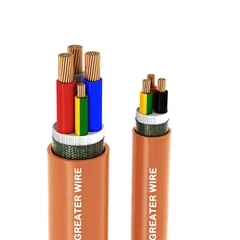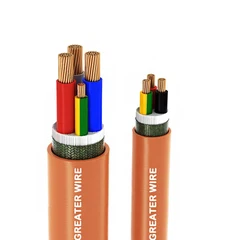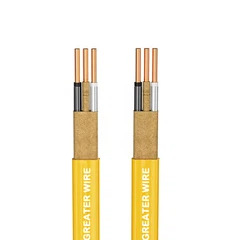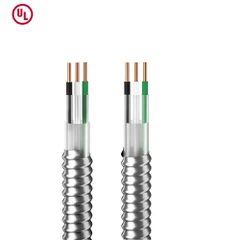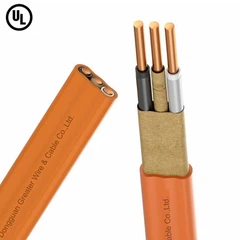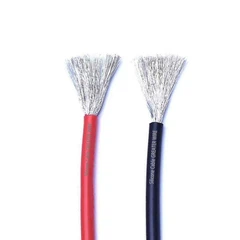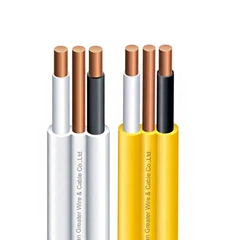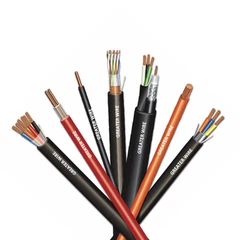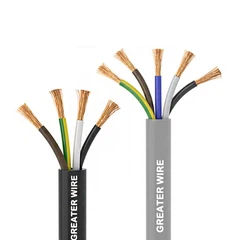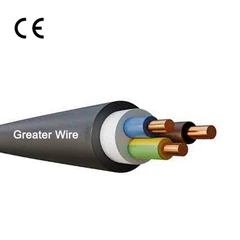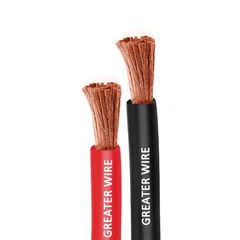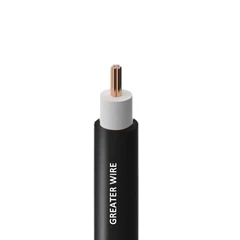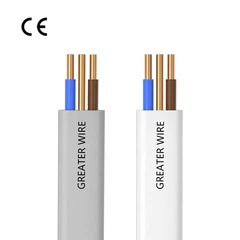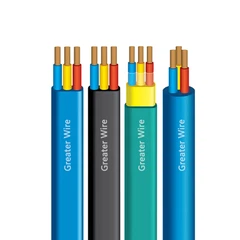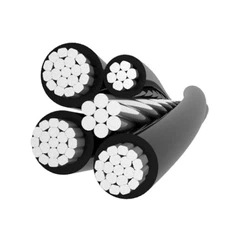1. What are THHN wire?
THHN stands for Thermoplastic High Heat-resistant Nylon-coated, which is a UL standard certified cable with the following features:
Working temperature: up to 90°C in a dry environment
Insulation material: PVC (polyvinyl chloride) insulation, outer nylon sheath
Rated voltage: 600V
Standards: Comply with UL 83, UL 1063, CSA C22.2 No. 75, etc.
2. Fundamental difference in conductor structure
The core difference between THHN Stranded Wire and THHN Solid Wire lies in the way the conductor is constructed:
THHN Solid Wire is composed of a complete, unsegmented copper conductor. This structure is simple, has excellent conductivity, high mechanical strength, but poor flexibility.
THHN Stranded Wire is composed of multiple fine copper wires twisted together to form a complete conductor. This structure enhances the flexibility of the wire, making it easier to adapt to complex routing or bending requirements.
This difference in conductor structure directly determines the performance difference between the two in use, and also affects their applicable environment and working life.
| Features | THHN Solid Wire | THHN Stranded Wire |
| Conductor construction | Single-core copper conductor | Stranded copper wire conductor |
| Flexibility | Hard, almost unbendable | Extremely flexible and bendable |
| Current carrying capacity | Relatively low (due to poor heat dissipation) | Relatively high (due to better heat dissipation) |
| Seismic resistance | Poor (easy to break) | Excellent (suitable for vibration environment) |
| Installation complexity | Simple installation, suitable for pipe penetration | Complex installation, terminal processing required |
| Applications | Fixed wiring, such as residential walls | Equipment interior, distribution cabinet, flexible wiring required |
3. Flexibility and operability
In electrical installation scenarios that require frequent bending, detours or pipe penetration, the flexibility of the wire is particularly important. THHN Stranded Wire is softer and easier to bend than THHN Stranded Wire because it is made of multiple strands of filaments twisted together, making it more suitable for narrow spaces and complex structures.
In contrast, THHN Solid Wire is relatively rigid due to its single-strand structure. It has obvious advantages when running long distances or in straight lines, but it is difficult to install in scenarios that require bending, coiling or passing through tortuous pipes, and special tools may be required for processing.
Therefore, from the perspective of flexibility, THHN Stranded Wire is more suitable for occasions where space is limited or high-frequency wiring changes are required, while THHN Solid Wire is more suitable for stable and regular wiring environments.
4. Differences in electrical performance
Although the conductor materials of the two types of THHN cable are the same, both are THHN copper wire with excellent conductivity, they perform slightly differently in high-frequency environments or long-distance transmission.
THHN Solid Wire has a slightly higher conduction efficiency in theory, especially in DC systems or low-frequency AC systems, where the current is mainly concentrated inside the conductor as a whole. Solid THHN Wire can provide lower resistivity and stronger current carrying capacity.
In high-frequency AC systems, due to the existence of the "skin effect", the current tends to flow on the surface of the conductor. The multiple surface areas of the stranded wire can more effectively disperse the current, making its performance advantage in high-frequency systems more obvious. In addition, the structure of the stranded thhn building wire also helps to reduce electromagnetic interference.
Overall, Solid thhn electrical wire has slightly better conductivity in low-frequency, DC systems, while Stranded thhn electrical wire has more advantages in high-frequency, complex wiring systems.
5. Differences in installation and wiring methods
From the perspective of installation, Stranded thhn cable and Solid thhn cable also have significant differences in wiring methods.
THHN solid copper wire is more suitable for insertion into terminals or screw-type connectors. Its rigid structure is easy to crimp and lock, and is commonly found in fixed places such as electrical panels and junction boxes. It is easy to install and has high stability, especially suitable for permanent installation.
THHN stranded copper wire is more flexible, so crimping terminals or welding are often used when wiring to prevent copper wire bifurcation. In some connection methods, if an adapter is not used, poor contact or increased resistance may result. Therefore, the installation of Stranded thhn cable requires higher technical requirements, and professional tools are required for stripping, crimping or crimping.
When operating unskilled, Solid thhn cable is faster to install; but in projects that require winding or active wiring, Stranded Wire shows greater flexibility.
6. Application fields and applicable occasions
Due to different performance characteristics, the choice of the two types of cable thhn in actual applications also has some emphasis.
THHN Solid Wire is usually used for permanent electrical wiring in buildings, such as distribution cabinets, wall pipe wiring, electrical panels and switchgear. Its rigidity is suitable for neatly arranged and clearly structured installation environments.
THHN Stranded Wire is more suitable for industrial equipment, power tools, motor control, machine tool control cabinets and other applications that require frequent movement or complex structures, especially for internal connection lines or flexible wiring scenarios.
In addition, in transportation vehicles (such as cars, ships, and airplanes), due to the small space and the need for vibration resistance, stranded thhn wire are usually preferred.
7. Durability and Mechanical Properties
In terms of durability, the two conductor types also have their own advantages.
Solid wire thhn has strong mechanical strength and oxidation resistance in fixed installation scenarios due to its simple structure and no internal twisting gaps. It has a low probability of breakage, especially in a static environment with a long service life.
Although stranded thhn wire has excellent flexibility, it performs better in high-frequency bending and frequent vibration situations, and is not easy to break or fatigue fracture. In dynamic environments, its reliability is better than thhn solid wire.
In other words, Solid thhn electrical wire is more suitable for "static" applications, while Stranded thhn electrical wire is more suitable for "dynamic" scenarios.

8. Comparison of Cost and Economy
In terms of cost, THHN Solid Wire is usually cheaper. This is due to its relatively simple manufacturing process, high production efficiency, and low material loss. Therefore, in large-scale construction projects, if the wiring path is clear and relatively regular, the use of thhn solid wire can save a lot of costs.
In contrast, the production of THHN Stranded Wire involves the twisting process of multiple strands of fine wires, which has higher labor and machine costs, and the price per unit length is usually higher than that of solid thhn cable. However, if the labor savings and higher reliability brought by its flexible installation are taken into account, Stranded thhn cable may actually be more economical in some specific projects.
Therefore, the choice of wire should not only look at the material price, but also need to be considered in combination with the complexity of installation and the overall budget.
9. THHN wire standards and certifications
Both thhn stranded wire and thhn solid wire must comply with the following standards:
UL 83: National Electrical Manufacturers Association (NEMA) standard
CSA: Canadian Standards Association certification
RoHS: Restriction of Hazardous Substances Directive
VW-1 flame retardant test: vertical flame burning test
In addition, THHN stranded wire is often used in industry as UL 1063 MTW wire (Machine Tool Wire).
10. Market Status and Optional Specifications
In the electrical material market, both THHN Stranded Wire and THHN Solid Wire are widely available. The former usually provides specifications from AWG 14 solid thhn to wire thhn 10 solid, while the latter usually provides specifications from AWG 14 stranded thhn wire to thhn stranded copper wire 1/0 or even larger. Users can choose the appropriate model based on factors such as current carrying capacity, laying method, voltage level, etc.
Generally speaking, small specifications (such as 14 thhn solid wire, 12 thhn solid copper wire, 10 thhn solid wire) are more often in the form of THHN Solid Wire, which is suitable for residential wiring; while large specifications (such as 4 gauge thhn cable, 500 mcm thhn wire, 4 0 thhn wire) are mostly thhn Stranded Wire, which is convenient for wiring and bending. In addition, there are also rich color options, such as black, red, white, blue, green, etc., which are used to identify different circuit uses.


11. How to choose the right type of THHN wire
Although THHN Stranded Wire and THHN Solid Wire have the same material and consistent standards, they have their own advantages and disadvantages in terms of flexibility, electrical performance, installation methods, and application fields due to different conductor structures.
The following aspects should be considered comprehensively when choosing:
1.Wiring complexity: If the wiring needs to be bent multiple times, Stranded Wire is recommended.
2.Application environment: Solid Wire is preferred for fixed wiring and wall pipe penetration, and Stranded Wire is used for internal connection of equipment or mobile scenes.
3.Installation tools and technical capabilities: If the on-site technology is inconvenient, Solid Wire is easier to install.
4.Budget and cost: Solid wire with a lower price can be preferred for large-scale construction.
5.Safety and regulatory requirements: Select according to equipment specifications and national standards to ensure safety and compliance.
Understanding and mastering the difference between THHN Stranded wire and Solid thhn cable is an important prerequisite for ensuring efficient and safe operation of electrical systems. Through scientific selection, not only can construction efficiency be improved, but also the system service life can be extended, maintenance costs can be reduced, and long-term value can be maximized.

